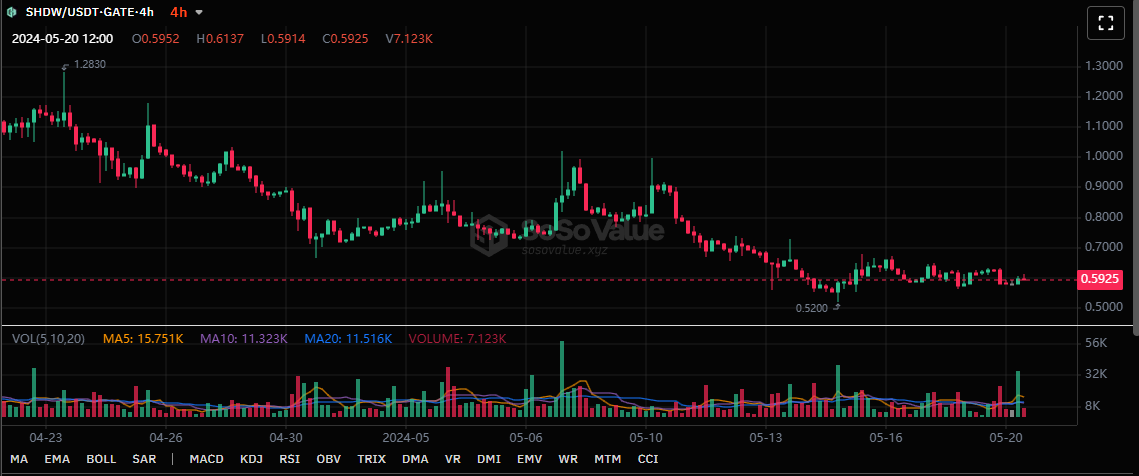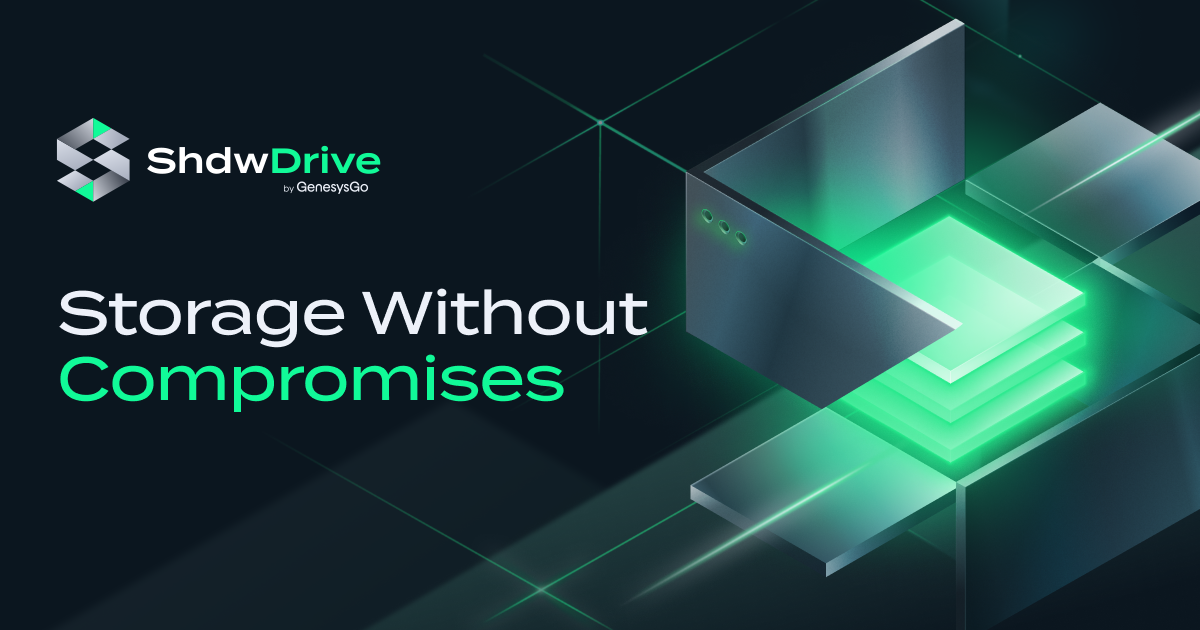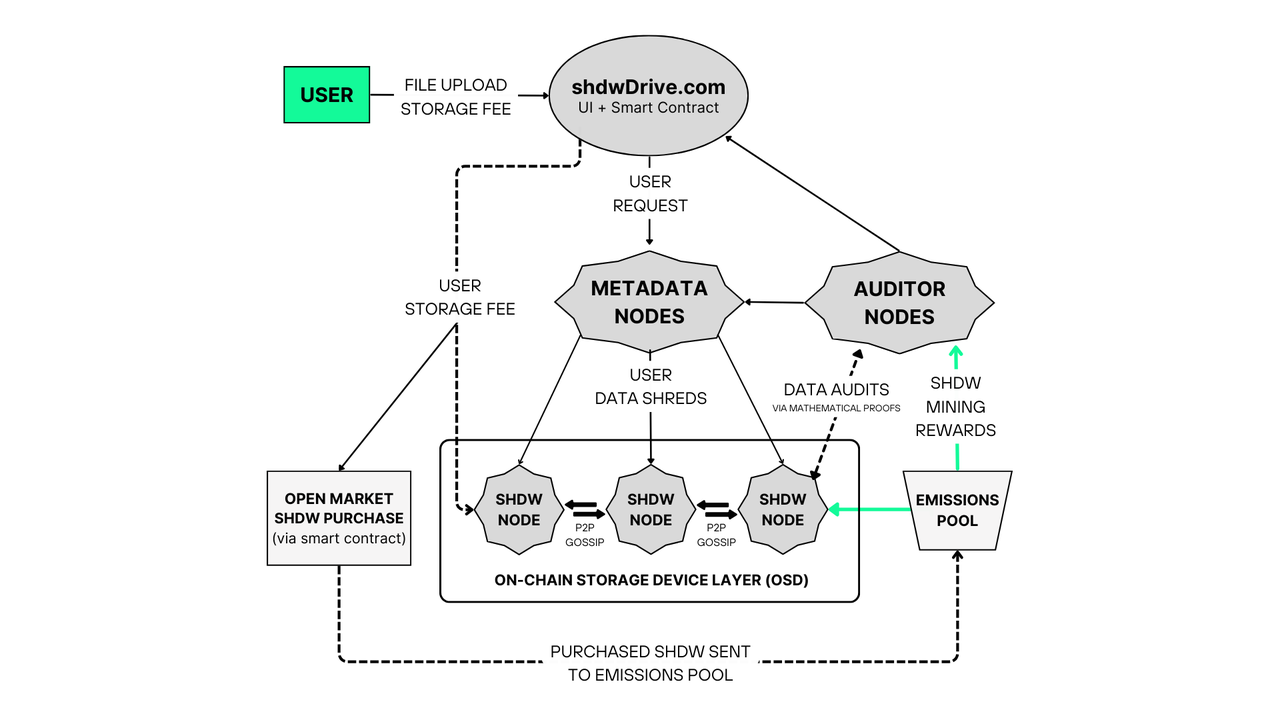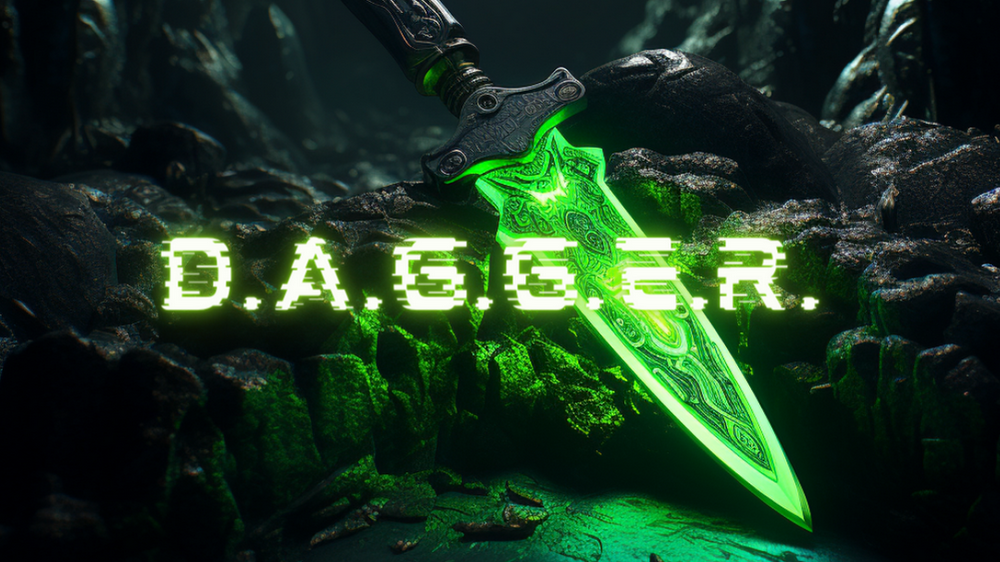The Shadow (SHDW) token is a utility token that supports the Shadow dePIN ecosystem, focusing on decentralized storage, computing, and network orchestration. SHDW is used to pay for services within the ecosystem, supporting decentralized data storage and other practical functions. As of now, the real-time price of SHDW is $0.5955, with a 24-hour trading volume of approximately $628,020, a decrease of 4.08%. It is ranked #415 on SoSoValue with a market capitalization of $9.58 million. The circulating supply is 16.09 million SHDW tokens, with a maximum supply of 16.905 million SHDW tokens.

Shadow, developed by GenesysGo, is a stable and high-performance cloud platform that supports a decentralized operator network. Shadow Drive is a decentralized, high-performance, and scalable object storage designed for Web3 builders. While activities such as NFT storage on Solana have often used third-party storage solutions like Arweave and Filecoin, these are incompatible with Solana and use their own tokens for payment. Shadow Drive, on the other hand, is the native storage system for the Solana ecosystem, designed to meet the growing storage needs of Solana's ecosystem.
In this article, we will delve into the specific details of the SHDW token, including its importance as a means of payment within the ecosystem and its role in promoting ecosystem development and user participation. Next, we will explore various aspects of the Shadow project and its token SHDW in detail to provide readers with a better understanding of this unique blockchain project.
Introduction to Shadow Drive: Decentralized Data Storage Layer Based on the Solana Ecosystem
Shadow Drive is a decentralized data storage layer within the Solana ecosystem, aimed at meeting the growing storage needs of the Solana ecosystem. In the past, activities such as NFT storage often used third-party storage solutions like Arweave and Filecoin. However, these solutions are often independent storage blockchains and are not compatible with Solana, thus unable to keep up with Solana's speed. To address this issue, the Solana ecosystem urgently needs a native storage system, leading to the emergence of Shadow Drive.
Shadow Drive is a storage program based on the open-source software Ceph, which provides a unified software-defined solution supporting block storage, file storage, and object storage, with its effectiveness widely validated. The GenesysGo team combined Ceph's open-source solution with Solana's Proof of History (PoH) mechanism to create Shadow Drive. Users can upload data to Shadow Drive by paying a small amount of $SHDW fees.

On the other hand, the ShdwDrive platform is a high-performance cloud storage platform developed by GenesysGo, fully supported by a decentralized operator network and fully integrated with the Solana blockchain. The platform utilizes Solana's innovative Proof of History (PoH) consensus mechanism to ensure the order and integrity of blocks through time sequencing, thereby enhancing data security. ShdwDrive also provides fast batch upload capabilities and a content delivery network (CDN) to ensure efficient uploading and accessing of data stored on the platform. Additionally, ShdwDrive offers a rich set of development tools and interfaces, including a command-line interface (CLI) and multi-language software development kits (SDK) to meet developers' needs.
The core technology of the ShdwDrive platform is the DAGGER consensus engine, a trustless decentralized consensus protocol. DAGGER adopts a directed acyclic graph (DAG) data structure to provide efficient data storage and management for data-intensive applications. Compared to traditional blockchains, DAGGER features parallel processing of data tasks, no need to wait for block confirmations, and dynamic adjustments, thereby improving system performance and scalability. Compared to other traditional platforms, DAGGER offers higher throughput, faster response times, and greater efficiency, making the ShdwDrive platform an indispensable part of the Solana ecosystem.
Understanding ShdwDrive's Economic Model and Value Proposition to Find Opportunities for Investors
ShdwDrive aims to create a stable, valuable, and sustainably growing long-term community, with the most important means of achieving this vision being its token economic model designed to bring value to network users and long-term SHDW holders. By reducing the token circulation speed, adopting a halving schedule, rewarding SHDW holders for participating in protecting and expanding the ShdwDrive network, and enhancing network stability and community participation through shared staking and slashing mechanisms, ShdwDrive's economic management approach aims to transform token holders into active participants, encouraging them to actively protect the network and benefit all stakeholders.
Rewarding holders for participating in the network through staking is a core part of ShdwDrive's economic system design process, creating value for both the network and the holders. shdwNode operators, as the foundation of the SHDW network, are required to stake SHDW to ensure their position in the network before connecting servers to the ShdwDrive network and receiving rewards, serving as a commitment fee to ensure their serious and dedicated participation in managing the network. When a shdwNode is slashed, the wallet associated with that node will be penalized, losing 5% of the staked SHDW. For regular SHDW holders, they can delegate their SHDW tokens to shdwNode operators through smart contracts and share the rewards received by the node. This shared success model promotes community cohesion and incentivizes both parties to contribute to the network's growth.

A majority of the fees paid by end users of ShdwDrive (60-75%) are directly passed on to the operators running shdwNode as rewards and compensation for individuals, groups, or entities with actual servers, and this portion of income is not shared with SHDW holders who delegate their tokens to shdwNode operators. The remaining fees for storage payments will be used to purchase SHDW on the open market and send the purchased SHDW to the release pool. This buyback mechanism helps maintain the liquidity of the SHDW token market, ensuring a clear and verifiable link between ShdwDrive revenue growth and SHDW token value, aiming to make the ShdwDrive network token economy as sustainable as possible in the long term.
To control the supply and enhance the value of SHDW, the project proposes sending 7,000,000 SHDW tokens back to the team, locked in a smart contract and released over time. According to the current model, the annual release amount paid to ShdwOperators (shdwNode and Audit Node operators) is 1,400,000 - 2,000,000 SHDW. This amount will halve every two years, reducing the number of new tokens entering the market. The project believes that this scarcity mechanism may increase the value of SHDW over time, as it encourages network participants to become early supporters of ShdwDrive and DAGGER technology, creating a sense of urgency by offering higher rewards to early supporters.

In the emerging crypto economy, the economic model of ShdwDrive provides an innovative approach to incentivize community participation and holding, while ensuring the health and sustainability of the network. By rewarding active contributors to the network and maintaining token value through supply control and revenue distribution, ShdwDrive's economic management approach aims to promote long-term community building and network growth.
Shadow Drive may bring more innovative changes to the Web3 world, and its future trends are worth watching
This article introduces the Shadow platform in the Solana ecosystem and the related ShdwDrive platform, both designed to meet the growing storage needs of the Solana ecosystem with decentralized data storage solutions.
Shadow Drive, based on the open-source software Ceph and combined with Solana's PoH mechanism, provides users with storage services supported by the native token $SHDW. ShdwDrive, developed by GenesysGo, is a high-performance cloud storage platform fully integrated with the Solana blockchain, utilizing its innovative PoH consensus mechanism to ensure data security, while also offering fast batch upload capabilities, a content delivery network (CDN), and a rich set of development tools and interfaces.
In summary, the emergence of the Shadow platform and ShdwDrive platform brings new storage solutions to the Solana ecosystem and opens up more possibilities and opportunities for the gaming ecosystem. In the future, as these platforms continue to develop and improve, they will bring more convenience and innovation to users and developers.
免责声明:本文章仅代表作者个人观点,不代表本平台的立场和观点。本文章仅供信息分享,不构成对任何人的任何投资建议。用户与作者之间的任何争议,与本平台无关。如网页中刊载的文章或图片涉及侵权,请提供相关的权利证明和身份证明发送邮件到support@aicoin.com,本平台相关工作人员将会进行核查。




